Introduction
- Animals are fed for the purpose of production and body maintenance.
- The edible material given to animals is called food.
- It is digested, absorbed and· utilized in the body.
- Nutrients are organic and inorganic substances contained in the food materials.
Components of Food material
- water,
- protein,
- carbohydrates,
- fats and oils,
- vitamins
- mineral salts.
Water
Sources
- Free water (through drinking)
- Bound water (contained in feeds).
- Metabolic water (obtained from oxidation of food).
Functions
- Regulates body temperature.
- Transport agent in the body.
- Universal solvent in the body.
- Gives shape to the cells (turgidity).
- Acts as a lubricant.
- Acts as constituent of body fluids.
Factors Determining the Requirements of Water by Livestock
- Production level.
- Amount of dry matter eaten.
- Temperature of the surrounding area.
- Type of animal.
- Type of food eaten.
Protein
Sources:
- Groundnut cakes,
- cotton seed cakes,
- fish meal,
- meat meal.
Functions:
- Growth of new tissues.
- Repair of worn out tissues (body building).
- Synthesis of antibodies.
- Synthesis of hormones and enzymes.
- Production of energy during starvation.
Digestion of Proteins
In non-ruminants, protein digestion takes placed in the stomach.
- Food is subjected to mechanical breakdown through chewing into small particles.
- Protein is acted on by enzymes to turn into amino acid which is assimilated into the bloodstream.
In ruminants, protein digestion initially takes place in the rumen.
- Food is acted on by micro-organisms into microbial protein.
- Later, enzymatic action takes place in the “true stomach” or abomasum where proteins are broken down into amino acids which are then assimilated into the bloodstream.
Carbohydrates
Sources:
- Cereals,
- tubers
- commercially mixed feeds.
Functions:
- Supply energy and heat to the body.
- Excess is stored in form of fat for insulation of the body.
Digestion of Carbohydrates
- In non-ruminants;
- carbohydrate feeds are broken down by chewing into small particles.
- Then enzymatic action further breaks down carbohydrates into glucose, fructose and galactose which are then assimilated into the bloodstrea
- In ruminants;
- mechanical breakdown of carbohydrate feeds is followed by microbial activities which break down cellulose into volatile fatty acids.
- These are absorbed through the rumen walls.
- Some carbohydrates are broken down by enzymatic action in the “true stomach” or abomasum.
Fats and Oils
Sources:
- Cotton seeds,
- soya beans
- groundnuts.
Functions:
- Supply energy and heat to the body.
- Excess is stored as fat adipose tissues.
- Source of metabolic water in the body.
- Required for the development of neural system.
- Insulator in the body.
Digestion of lipids in Ruminants
- Fats are hydrolysed in the rumen into fatty acids and glycerol.
- Others are fermented into propionic acid,
- The shorter chains are passed to the true stomach where enzymatic action takes place.
Vitamins
Sources:
- Green materials,
- dried grass
- fish liver oil.
Functions:
- Protects the body against diseases.
- Regulate the functions of all parts of the body.
- It acts as a co-enzyme in the body.
Examples:
- Vitamin A,
- vitamin B2
- vitamin C,
- vitamin E
- vitamin K.
Minerals
Sources:
- Salt licks,
- bone meal,
- legumes
- cerea
Functions:
- Form part of the tissues such as bones and teeth.
- Work together with the enzymes.
- Act as acid -base balances.
- Act as electrolyte in the body.
- Regulate osmotic balance in the body.
Examples:
- Calcium,
- phosphorus,
- magnesium,
- iron,
- iodine,
- sodium
- chlorine.
Calcium and phosphorus –
-
- Needed for teeth and bone formation.
- Lack of these minerals leads to rickets, osteomalacia.
- Lack of iron leads to anaemia.
Classification of Animal Feeds
This is based on nutrient composition:
- Roughages.
- Concentrates.
- Feed additives.
Roughages
- Are feeds of low available nutrients per unit weight and high fibre content.
Examples:
- Dry roughages,
- succulent roughages,
- residues from agricultural by products and conserved materials.
Characteristics
- Low level of available nutrients.
- Have high level of calcium especially legumes.
- Good source of vitamin A.
- Have high fibre content.
Concentrates
- Are feeds of high available nutrients per unit weight.
Examples:
- Maize germ and bran,
- malt extract,
- milk products,
- soyabeans,
- oil seed cakes,
- meat meal,
- bonemeal
- bloodmeal.
Characteristics
- Low fibre content.
- Feed content is consistently high.
- High digestibility of the feed.
- High in nutrient content.
Feed Additives
These are substances added to the feed to increase;
- palatability,
- medication
- or hormones to make animals produce more.
There are two types:
- Nutritive additives, such as mineral licks (maclick).
- Non-nutritives additives, such as;
- medicants (coccidiostats),
- Stilboestrol (used in beef animals)
- oxytocin (to increase milk let down).
Functions
- Stimulate growth and production.
- Improve feed efficiency.
- Prevent disease causing organisms.
Compounded Feeds
- These are the feeds prepared and mixed by use of machines.
- These feeds can be round, pelleted, pencils, cubes or mash.
Poultry feeds can be categorized as:
- Chick mash having 20% D.C. given to chicks.
- Growers mash having 16% D.C. given to growers.
- Layers mash having 12-15% D.C.P. given to layers.
Meaning of terms used to express feed values
- Nutritive ratio (NR):
- Is the proportion of protein to carbohydrates and fats.
- In young animals 1:3:6
- In old animals 1:8.
- Crude protein (C.P): Is the total amount of protein contained in a feed.
- Digestible Crude Protein (D.C.P): Is the portion of crude protein which an animal is capable of digesting.
- Crude Fibre (C.F.):
- Is the total amount of fibre contained in a feed.
- It is mainly lignin and cellulose.
- Digestible Fibre (D.F.): Is the portion of the total fibre contained in a feed which an animal is capable of digesting.
- Dry Matter (D.M.): Is the material left in a feed after water has been removed.
- Starch equivalent (S.E.): Is the amount of pure starch which has the same energy as 100kg of that feed.
- Total Digestible Nutrients (T.D.N.): Is the sum of all the digestible organic nutrients such as fats, proteins, carbohydrates and fibre.
Computation of Livestock Rations
Ration:
- Is the amount of food that will provide essential nutrients to an animal in a 24 hour period
- to enable that animal to meet its maintenance and production requirements.
Balanced ration:
- Is the ration that contains all the essential nutrients in required amounts and in the right proportion.
Maintenance ration:
- is the portion of a feed required by an animal to continue with the vital body processes with no loss or gain in weight.
Production ration:
- Is the feed required by animals over and above maintenance ration to enable the animal to produce;
- for example; milk, eggs, wool, grow in size, perform work, reproduce and fatten.
Steps in ration formulation
- Finding out the animal’s feed requirement based on body weight.
- List all the available feeds, with their nutrient composition and their prices.
- Calculate the amount of ingredients required in the ration to meet the animals needs.
Methods used in ration formulation
- Trial and error method
- Pearson’s square method
- Graphical method
- Linear programming(use of computers)
Examples;
Mix a Pigs ration 22% protein using soya bean meal 40% DCP and maize meal containing 8%DCP.
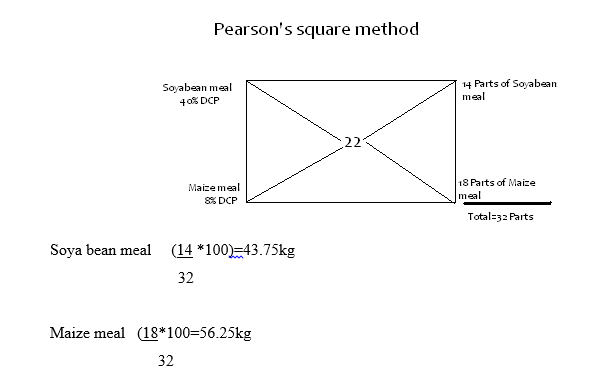
Digestion and digestive systems
- Digestion is the process through which food is broken down into small particles in the alimentary canal ready for absorption into the blood stream.
Digestion of food in livestock takes place in three stages;
- Mechanical breakdown and chewing
- Microbial breakdown by bacteria and protozoa in the rumen of ruminants
- Chemical breakdown by enzymes.
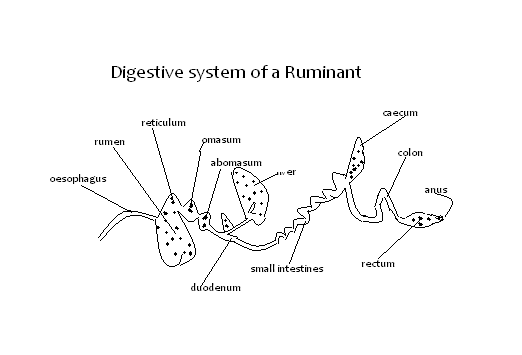
Rumen-
- Breakdown of food by micro-organisms and also stores food.
- Synthesis of vitamin B-complex.
- Synthesis of amino acids from ammonia gas.
- Proteins are broken to peptides and amino acids.
- Carbohydrates are broken to volatile fatty acids.
Reticulum:
- Separates large food particles from the small particles.
- Retains foreign materials such as stones, hard wood and sand.
Omasum:
- Breaks up food by grindin
- Reduction of water content from the feed stuff.
Abomasum:
- Enzymatic digestion takes place here ..
- Contains some microbes which digest cellulose.
- Breaks up food by grinding.
- It is also found in non-ruminants.
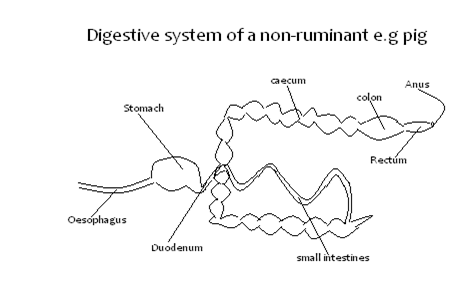
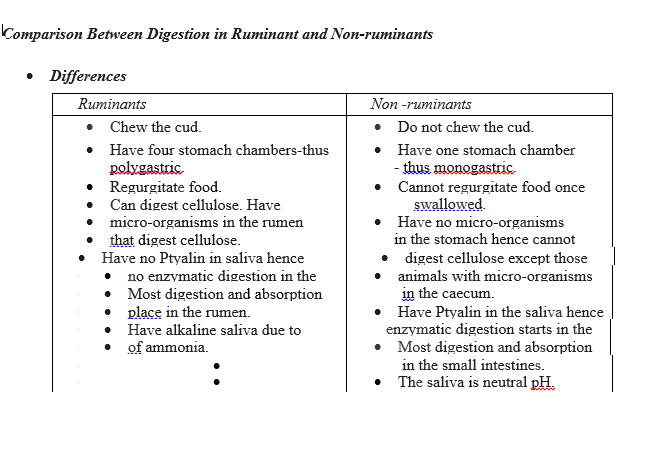
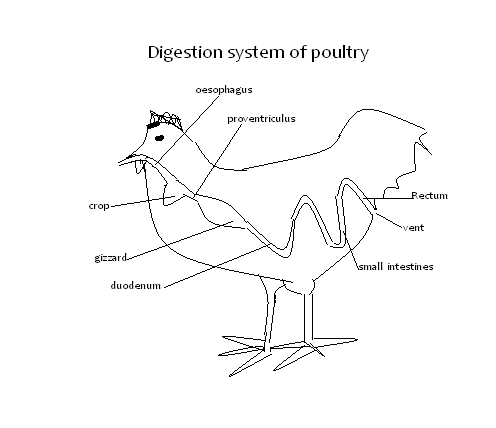
Functions of the Parts of Poultry
Crop:
- Storage of food.
- Softening of food by secretions from small glands in the walls.
Proventriculus: Enzymes start the breakdown of food.
Gizzard:-Crushes and grinds the coarse food (has small grit and gravel).
Comparison Between Digestion In Ruminants and Non–Ruminants
Similarities Between Digestion In Ruminants and Non–Ruminants
- Digestion in young ruminants is similar to that in non-ruminants as they do not have a developed rumen-reticulum complex.
- Final protein digestion takes place in the small intestines in both cases.
- Water absorption takes place in the colon in both ruminants and non ruminants
